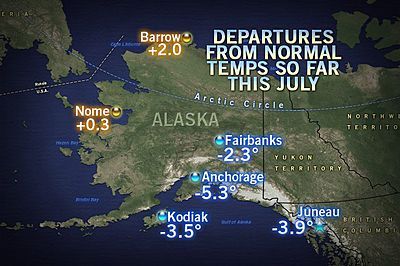
Anchorage Experiences Coldest First Half of July Ever

This article was provided by AccuWeather.com.
Looking for relief from the heat over much of the Lower 48 states? Head to coastal Alaska where they are experiencing the coldest first half of July on record!
Through the first 14 days of July, the average temperature in Anchorage was 53.1 degrees factoring in daily highs and lows, which makes it the coldest first half of the month on record according to the National Weather Service in Anchorage.
Should this temperature trend continue, it could threaten the record for the coldest July ever, which occurred in 1920 and had an average temperature of 54.4 degrees.
Typically this stretch of time is the warmest of the year. Instead, temperatures in the city of Anchorage are running 5.3 degrees below average.
Somedays have even turned out colder than cities on the Arctic Coast such as Barrow. On July 12th, the high temperature topped out at 54 degrees in Anchorage, while temperatures soared to 62 in Barrow (a whooping 15 degrees above average.)
Not only has it been cool, but residents of the Alaska city haven't seen much sunlight due to overcast skies and a persistent flow off the ocean. Rainfall through the first 14 days is running slightly above normal at 120 percent. But the clouds and cool temperatures have been the bigger story.
Sign up for the Live Science daily newsletter now
Get the world’s most fascinating discoveries delivered straight to your inbox.
The reason for the cool weather along the coast has been due to jet stream position. Normally it will fluctuate northward sending storms into western Alaska and allowing ridging to build over the southern and central part of the state at times.
Well this summer it's been consistently farther south sending storm after storm into the Gulf of Alaska, keeping a cool southeast flow of air aimed on the southern coast.
While heavy rain isn't common with this kind of a storm track, the flow will keep clouds and cool temperatures in the offing as long as it persists.
Anchorage hasn't been the only southern city feeling the chill. Homer, Alaska is running 5 degrees below normal for the month thus far while Palmer is running 3.8 degrees below average.
Residents of Anchorage and the southern coast shouldn't expect any big warm ups anytime soon as this pattern of storms moving into the Gulf of Alaska looks to persist at least through next weekend.
Looking for relief from the heat over much of the Lower 48 states? Head to coastal Alaska where they are experiencing the coldest first half of July on record!
Through the first 14 days of July, the average temperature in Anchorage was 53.1 degrees factoring in daily highs and lows, which makes it the coldest first half of the month on record according to the National Weather Service in Anchorage.
Should this temperature trend continue, it could threaten the record for the coldest July ever, which occurred in 1920 and had an average temperature of 54.4 degrees.
Typically this stretch of time is the warmest of the year. Instead, temperatures in the city of Anchorage are running 5.3 degrees below average.
Somedays have even turned out colder than cities on the Arctic Coast such as Barrow. On July 12th, the high temperature topped out at 54 degrees in Anchorage, while temperatures soared to 62 in Barrow (a whooping 15 degrees above average.)
Not only has it been cool, but residents of the Alaska city haven't seen much sunlight due to overcast skies and a persistent flow off the ocean. Rainfall through the first 14 days is running slightly above normal at 120 percent. But the clouds and cool temperatures have been the bigger story.
The reason for the cool weather along the coast has been due to jet stream position. Normally it will fluctuate northward sending storms into western Alaska and allowing ridging to build over the southern and central part of the state at times.
Well this summer it's been consistently farther south sending storm after storm into the Gulf of Alaska, keeping a cool southeast flow of air aimed on the southern coast.
While heavy rain isn't common with this kind of a storm track, the flow will keep clouds and cool temperatures in the offing as long as it persists.
Anchorage hasn't been the only southern city feeling the chill. Homer, Alaska is running 5 degrees below normal for the month thus far while Palmer is running 3.8 degrees below average.
Residents of Anchorage and the southern coast shouldn't expect any big warm ups anytime soon as this pattern of storms moving into the Gulf of Alaska looks to persist at least through next weekend.
© AccuWeather.com. All rights reserved. More from AccuWeather.com.












